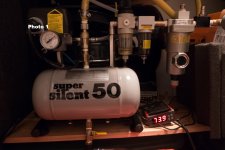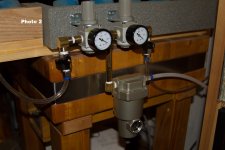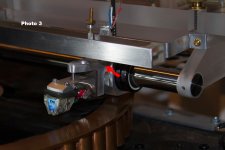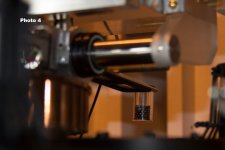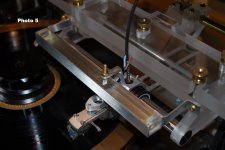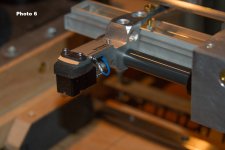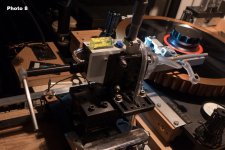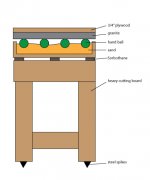Hi Raff,
Actually, I thought about moving the trough to the other side. But I gave it up because it involves a lot and I am using 2000 cst damping fluid now. The silicone fluid is thick and won’t spread out. It is much safer than you may think. However, I do agree that it is better to move the trough on the opposite side of head shell. It will be another project for me later on.
Jim
Actually, I thought about moving the trough to the other side. But I gave it up because it involves a lot and I am using 2000 cst damping fluid now. The silicone fluid is thick and won’t spread out. It is much safer than you may think. However, I do agree that it is better to move the trough on the opposite side of head shell. It will be another project for me later on.
Jim
I am posting some photos to show what I did.
Photo 1. This is Silentaire TC-50 compressor. I modified the compressor by adding a 10 gallon tank. Big tank increases stopping time. I also added a flow control valve to minimum the air flow. For air bearing arm, it only needs high pressure but low flow. To keep clean air, I added .3 micron and a .01 micron filters to form a air filter stage. I also installed two PC case fans to cool down the compressor with a thermal switch. The fans will be turned on at 90 F.
Photo 2. I use different air pressure for different arm. The moving bearing arm uses 52 psi and the moving shaft arm uses 56 psi. I also installed another .01 micron filter just before the air goes into the bearings to filter out the moisture.
Photo 3. This is the arm which I call it as moving bearing arm because its bearing moves. The carriage is made from a block of aluminum. Someone in UK was very kind and made it for me with his CNC machine. The carriage is designed by me under the inspiration of other fine air bearing tonearms. The critical part for this carriage is its head shell in relationship with the bearing. I marked it with red arrow in the photo. This connection point should be as high as possible.
I made a piece of shim to put between cartridge and head shell. The shim is made of two pieces of 3 mm carbon fibers glued together. The propose of the shim is to eliminate unwanted resonance.
Photo 4. This photo shows the construction of counter weight. The tail which holds the counter weight is covered with double side form tape to prevent ringing, therefore, to reduce the noise.
Photo 5. You can see the construction of bearing carriage from this photo. I use 1/16 ID latex tubing. Latex tubing is the softest tubing. But it can hold high pressure. The maximum pressure I can use is 52 psi.
Photo 6. This is the head shell of moving shaft( because its bearing is fixed and shaft moves) arm. The shim is made of one 3 mm piece of African black wood and one 3 mm carbon fiber. I also tried to connect the aluminum body of cartridge to ground, but I can’t tell if it makes any audible difference.
Photo 7. On the side of head shell, I glued a piece snake wood to reduce possible ringing.
Photo 8. I changed the weight distribution of counter weight after I shot the video. Most of the weight is now on head shell area. I did this because I found that I could hear some distortion on the most inner grooves of some records.
Photo 1. This is Silentaire TC-50 compressor. I modified the compressor by adding a 10 gallon tank. Big tank increases stopping time. I also added a flow control valve to minimum the air flow. For air bearing arm, it only needs high pressure but low flow. To keep clean air, I added .3 micron and a .01 micron filters to form a air filter stage. I also installed two PC case fans to cool down the compressor with a thermal switch. The fans will be turned on at 90 F.
Photo 2. I use different air pressure for different arm. The moving bearing arm uses 52 psi and the moving shaft arm uses 56 psi. I also installed another .01 micron filter just before the air goes into the bearings to filter out the moisture.
Photo 3. This is the arm which I call it as moving bearing arm because its bearing moves. The carriage is made from a block of aluminum. Someone in UK was very kind and made it for me with his CNC machine. The carriage is designed by me under the inspiration of other fine air bearing tonearms. The critical part for this carriage is its head shell in relationship with the bearing. I marked it with red arrow in the photo. This connection point should be as high as possible.
I made a piece of shim to put between cartridge and head shell. The shim is made of two pieces of 3 mm carbon fibers glued together. The propose of the shim is to eliminate unwanted resonance.
Photo 4. This photo shows the construction of counter weight. The tail which holds the counter weight is covered with double side form tape to prevent ringing, therefore, to reduce the noise.
Photo 5. You can see the construction of bearing carriage from this photo. I use 1/16 ID latex tubing. Latex tubing is the softest tubing. But it can hold high pressure. The maximum pressure I can use is 52 psi.
Photo 6. This is the head shell of moving shaft( because its bearing is fixed and shaft moves) arm. The shim is made of one 3 mm piece of African black wood and one 3 mm carbon fiber. I also tried to connect the aluminum body of cartridge to ground, but I can’t tell if it makes any audible difference.
Photo 7. On the side of head shell, I glued a piece snake wood to reduce possible ringing.
Photo 8. I changed the weight distribution of counter weight after I shot the video. Most of the weight is now on head shell area. I did this because I found that I could hear some distortion on the most inner grooves of some records.
Attachments
Very interesting,very studied work, it show us that when someone loves what he done he can buld masterpieces.Well done.
I thought I was done with air bearing tonearms, but one time I looked up eBay, I found someone was selling 1” air bushings and 40 mm round air bearings with great prices. So, I bought both lots. Once I got these air bushings and air bearings, I planned to build another air bearing tonearm. I know that 3/4” air bushing is an great improvement over 1/2” air bushing. I want to find out if 1” air bushing is another improvement over 3/4” air bushing.
First of all, I use 5 40 mm round air bearings as the feet for plinth and took down my mini “Brooklyn bridge”, a suspended mechanism for both air bearing arms. The 4 suspension feet on the SME table mainly hold the plinth and prevent the plinth moving side way. The platter and tonearms all float on the thin layer of air, 5 micron. The bearings are feed with 80 psi compressed air.
Right side air bearing foot.

Left side air bearing foot.
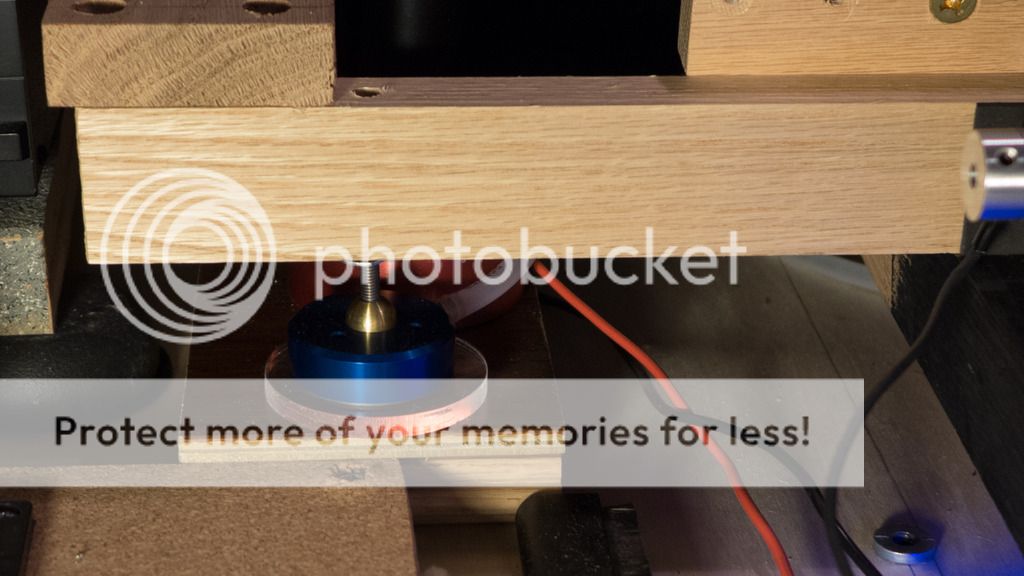
Middle area air bearing foot.

In the meantime, I also did some improvement on compressed air filter system by adding a desiccant air dryer.

Now, my latest and greatest air bearing tonearm. I want this 1” air bushing arm has the best sounding and the best looking as well. I paid great attention on its functionality and its appearance as much as I can. Every small details had been carefully thought out. Now, I can say that there are some small cosmetic details I could do better. But its functionalities meet my exceptions 100% except one small detail in functionality. I am planning to find an solution later on. This small detail has nothing to do with sound but with user friendly.
I reworked the all adjusting mechanism. The mechanism is very steady and accuracy now.
This is bottom part.

This is main adjusting mechanism. I painted even screws to make it looks nice.
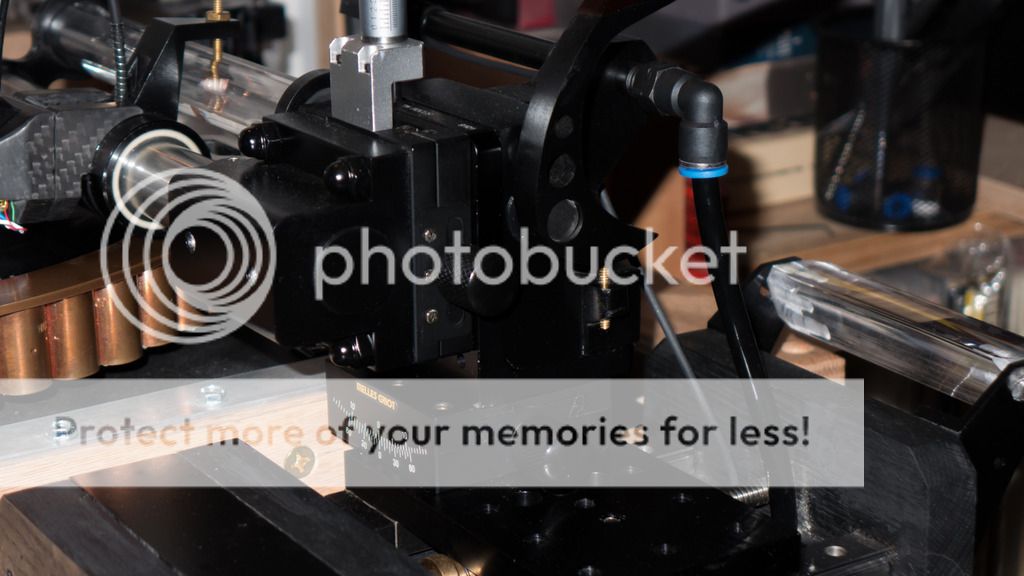
This is for adjusting the height of handle.

This is the handle to lift arm. It is made with snake wood.
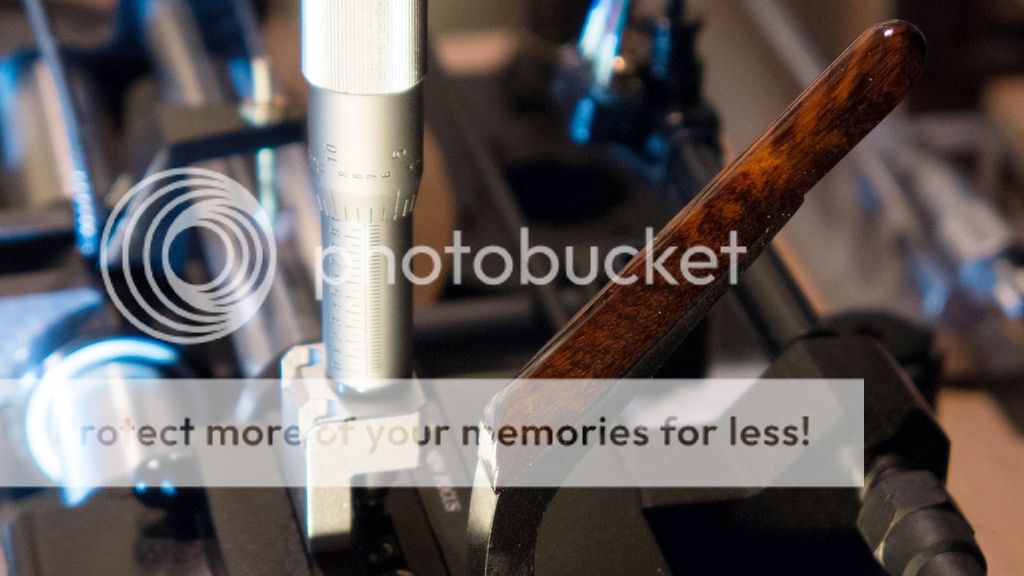
This is damping device. The silicone oil is kept in a plastic tubular with narrow opening. It is much safer now.
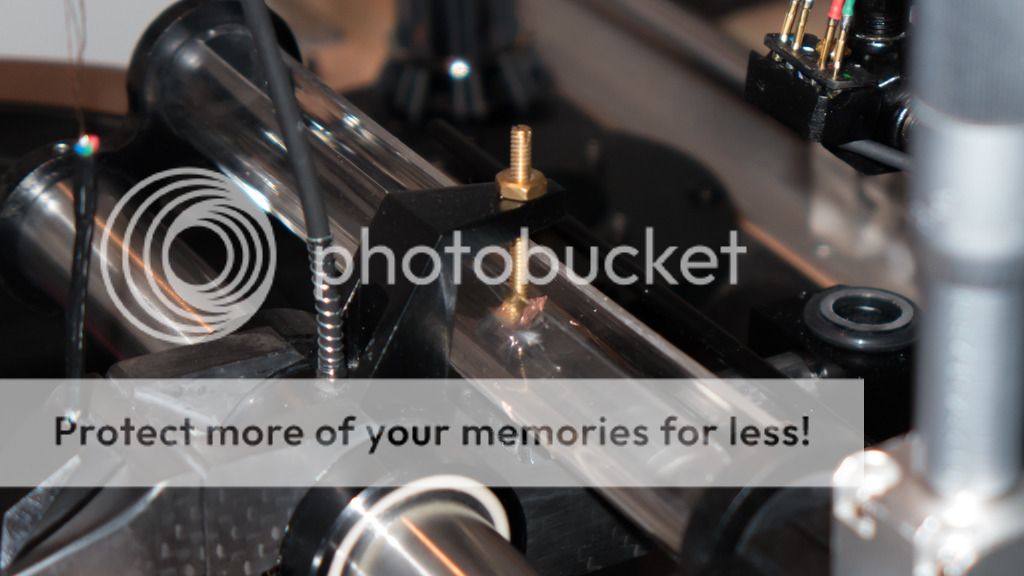
Some people may think the air supply tubing is problematic. I agree.
For air bearing tonearms(moving bearing kind), the main problem is air supply line. Air supply line will add resistance to the movement of air bearing. Here is what I did for my air bearing tonearms.
First, I use 1/16” latex tubing. Latex is more flexible than pvc. But latex can’t resist high pressure. The maximum air pressure I can use for latex tubing is 55 psi. I also use a small spring(taking from cheap retractable pen) to hold the joint. Please see the photo. It seems to me that Kuzma airline uses 3 or 4 mm pvc tubing so they can rise the air pressure to 65 psi. I have some 1/16 pvc tubing, too. But it is not as flexible as latex tubing.
The 1/16” latex tubing I use is special one. Usually, for 1/16” latex tubing, its wall is 1/32”. It will not resist even 55 psi. I had tried to order the tubing from different sources and finally I settled on the one I bought from eBay. The latex tubing I bought from eBay has thicker wall. Although it supposes to be 1/32” wall, too, its wall is actually thicker than 1/32”. I don’t know if it is manufacture’s error or something else, it works fine for me. It can resist higher pressure than usual ones.
I thought to add a micro stepper motor to the air line so the air line will move with the carriage. To add stepper motor can reduce the resistance but it can’t completely eliminate the resistance. After many experimenting, I don’t think it is necessary at all. Please check out the video. You can see how little resistance the air line has on my latest air bearing arm.
https://youtu.be/BlcrqSnh9V8
I think my solution is better than Kuzma’s and others. My tonearm can do up to 55 psi while Kuzma's can do 65 psi. 10 psi in air pressure will make no difference at all. I have tried all different air pressure starting from 30 psi and to 55 psi. I also tried 65 psi with 1/16” pvc tubing. I can’t hear the difference between 55 psi and 65 psi, but I can tell there was some resistance from 1/16” pvc air tubing under air pressure 65 psi.
I prefer high pressure on the moving bearing kind of tonearm. For moving shaft kind of air bearing arm, it sounds best at 45 psi and 50 psi.
This is counter weight. I use lead shots as weights. Every lead shot is .5 gram. So, this is the resolution of my weight adjustment. In my opinion, using lead shot is very convenient and effective.

I also installed two stripes of LED lights. The LED lighting stripes are not mainly for the appearance. I installed a remote control electric solenoid to shut off and turn on the air supply. The LED lighting stripes can give me a clear indication of the status of air supply. Yes. It makes the tonearm looks nice, too.
This is the LED lighting with remote control.
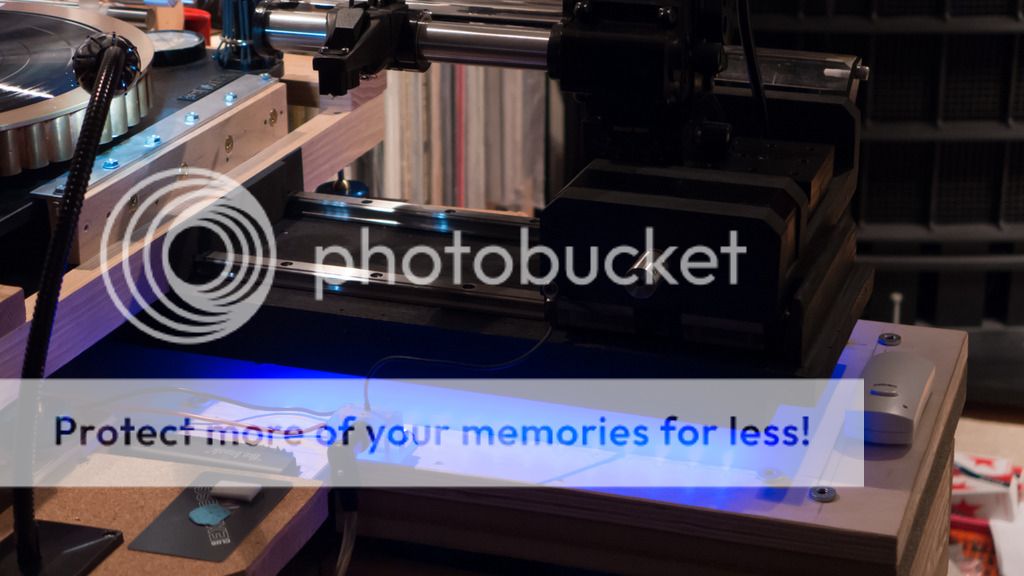
Growing in dark.

The head shell is made with all carbon fabric. I believe carbon fabric has very natural sounding. I coated two layers of epoxy liquid and used 1200 grit sand paper to finish the head shell.
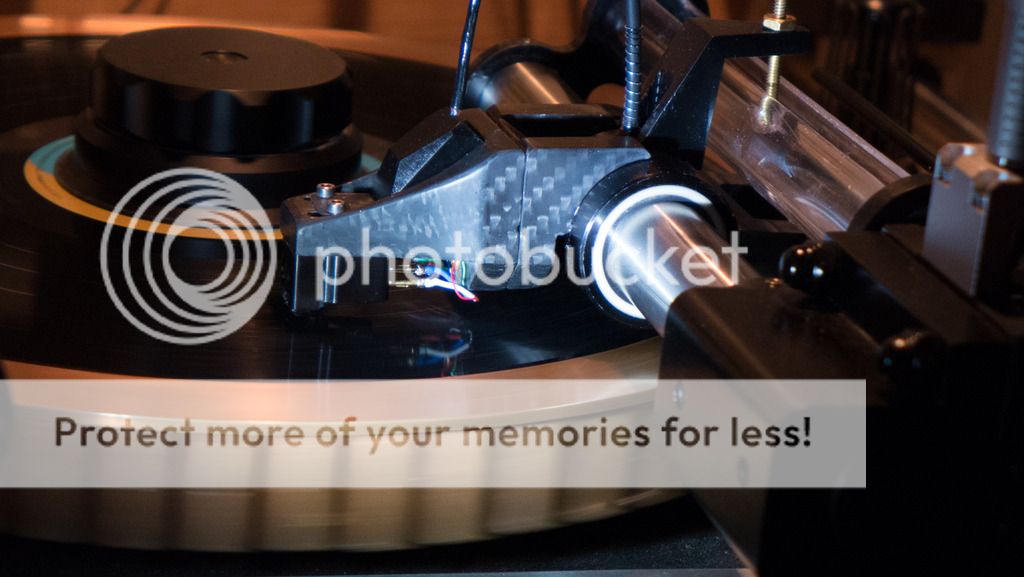
For adjusting zenith, I made one side of cartridge screw holes as a long channel and 2 3 mm holes on the another side. The long washer is made with copper.
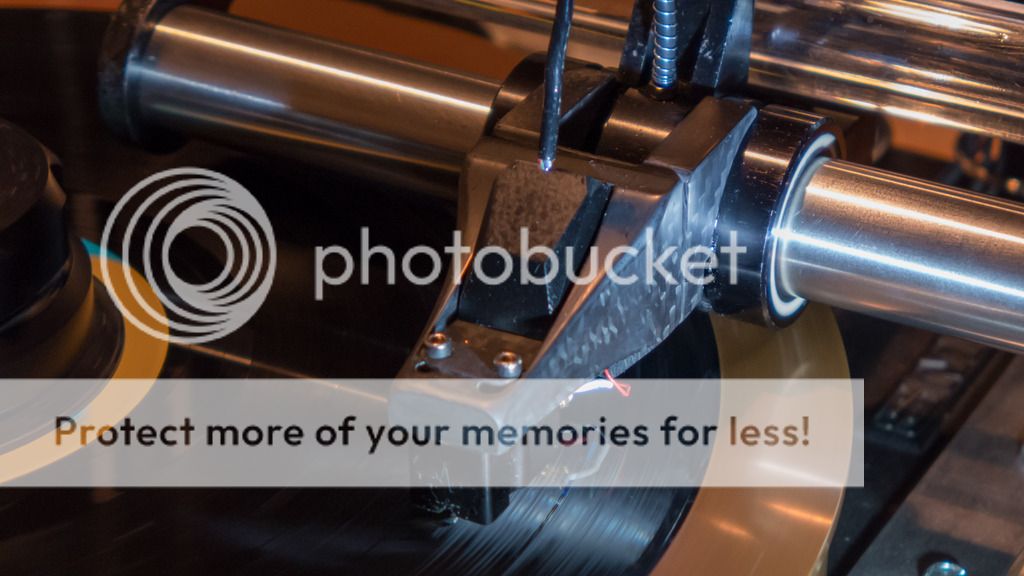
For adjusting azimuth, I use two #6 brass screws. The top one is in a curved channel and bottom one is fixed. If I loose the top screw, I can move the head shell to right or left. Azimuth will be changed while the head shell has very solid contact with the carriage.
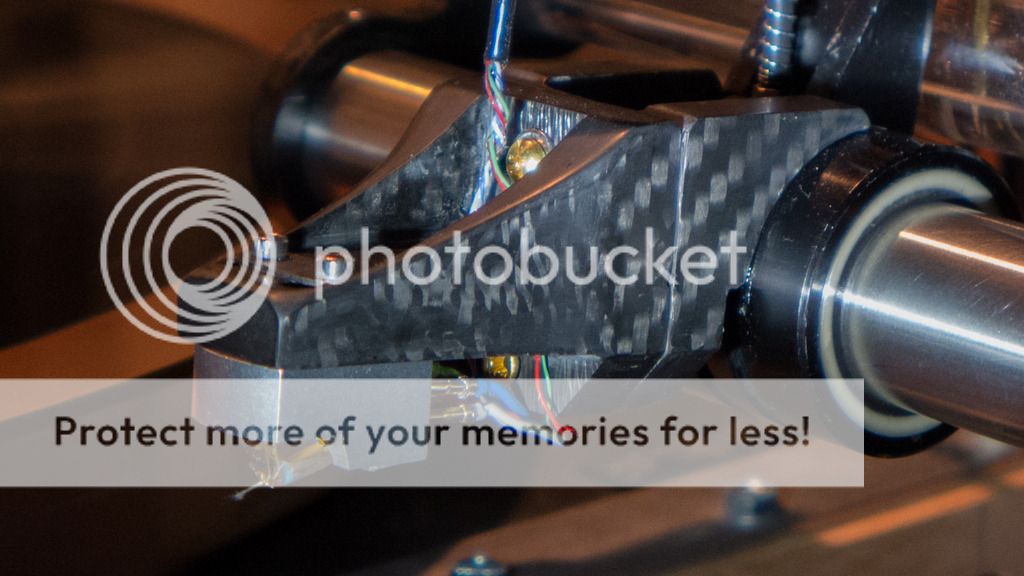
This is front view of the air bearing arm.
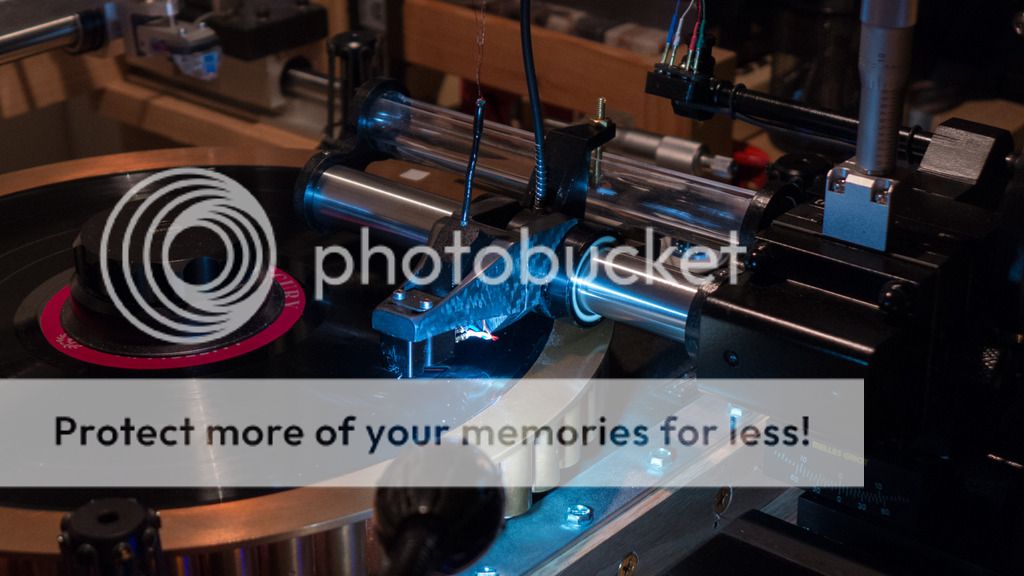
This is back view of the air bearing arm.
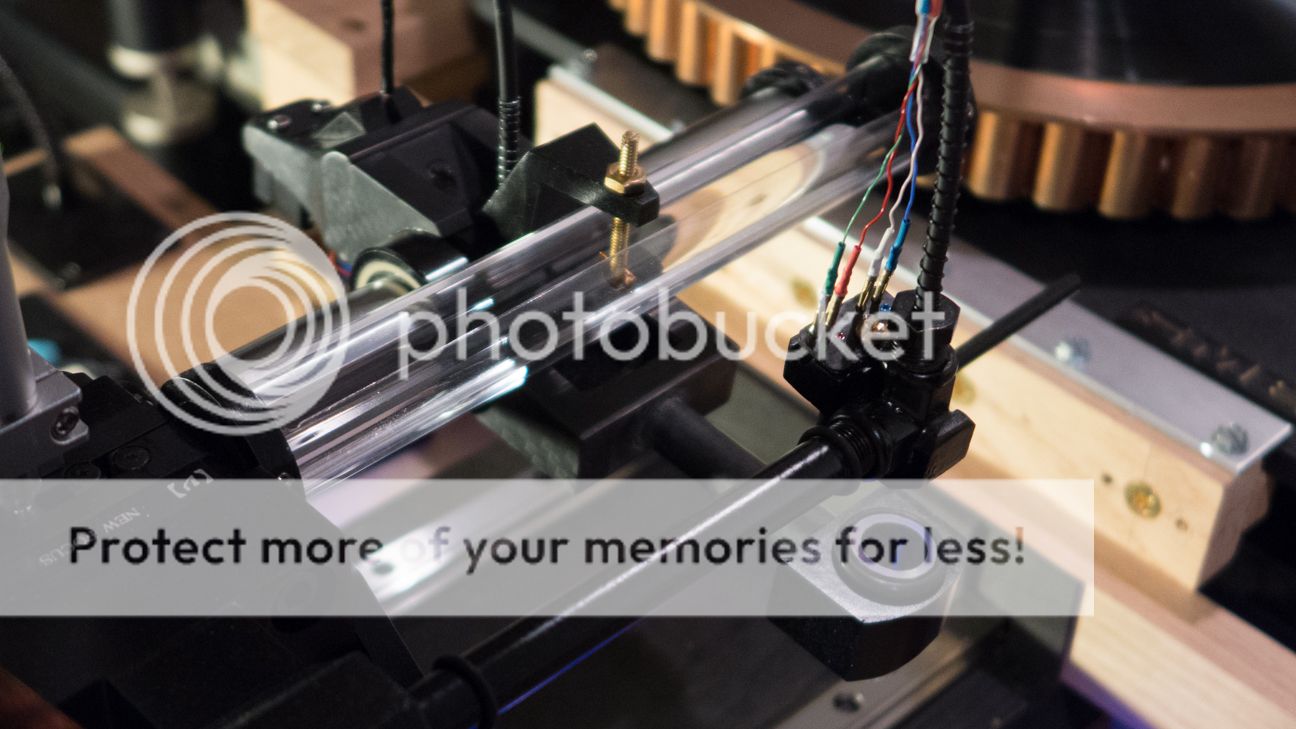
Another back view.
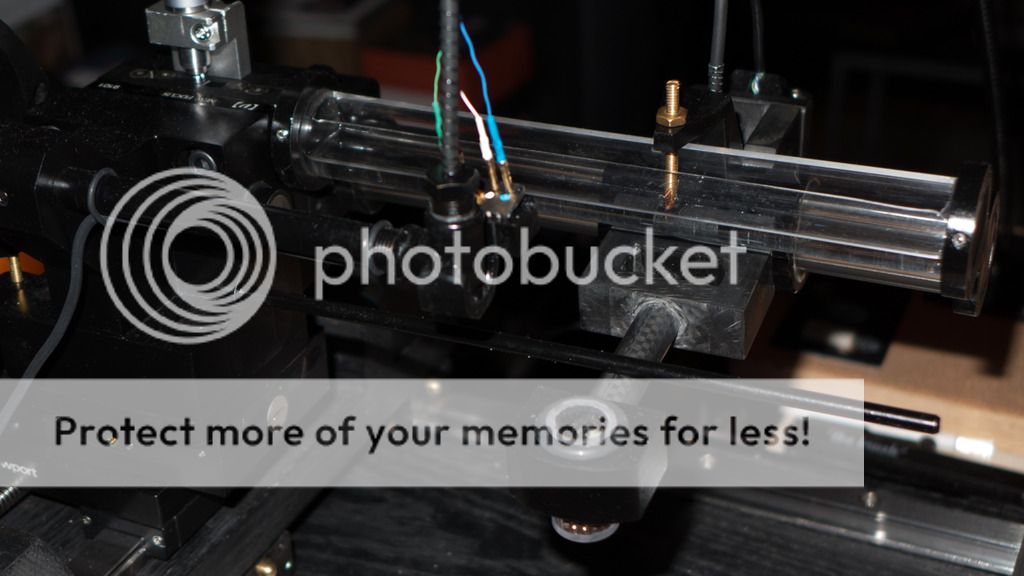
One inch air bearing arm is an improvement over 3/4” air bearing arm, but it is not as much as from 1/2” to 3/4” air bearing. The main improvements are mainly bass and sound stage. 1” air bearing is the most smooth running arm. I guess it is because 1” air bearing has the largest air contact area. The total weight for the carriage, head shell and counter weight for my 1” air bearing arm is almost 200 grams.
In order to get the best appearance and accuracy, I used outside CNC and water jet cutting services for two parts. CNC service is for the shaft bracket and water jet is for cutting the pieces of head shell.
The tonearm sounds wonderful. Now, I think I am done.
First of all, I use 5 40 mm round air bearings as the feet for plinth and took down my mini “Brooklyn bridge”, a suspended mechanism for both air bearing arms. The 4 suspension feet on the SME table mainly hold the plinth and prevent the plinth moving side way. The platter and tonearms all float on the thin layer of air, 5 micron. The bearings are feed with 80 psi compressed air.
Right side air bearing foot.

Left side air bearing foot.

Middle area air bearing foot.

In the meantime, I also did some improvement on compressed air filter system by adding a desiccant air dryer.

Now, my latest and greatest air bearing tonearm. I want this 1” air bushing arm has the best sounding and the best looking as well. I paid great attention on its functionality and its appearance as much as I can. Every small details had been carefully thought out. Now, I can say that there are some small cosmetic details I could do better. But its functionalities meet my exceptions 100% except one small detail in functionality. I am planning to find an solution later on. This small detail has nothing to do with sound but with user friendly.
I reworked the all adjusting mechanism. The mechanism is very steady and accuracy now.
This is bottom part.

This is main adjusting mechanism. I painted even screws to make it looks nice.

This is for adjusting the height of handle.

This is the handle to lift arm. It is made with snake wood.

This is damping device. The silicone oil is kept in a plastic tubular with narrow opening. It is much safer now.

Some people may think the air supply tubing is problematic. I agree.
For air bearing tonearms(moving bearing kind), the main problem is air supply line. Air supply line will add resistance to the movement of air bearing. Here is what I did for my air bearing tonearms.
First, I use 1/16” latex tubing. Latex is more flexible than pvc. But latex can’t resist high pressure. The maximum air pressure I can use for latex tubing is 55 psi. I also use a small spring(taking from cheap retractable pen) to hold the joint. Please see the photo. It seems to me that Kuzma airline uses 3 or 4 mm pvc tubing so they can rise the air pressure to 65 psi. I have some 1/16 pvc tubing, too. But it is not as flexible as latex tubing.
The 1/16” latex tubing I use is special one. Usually, for 1/16” latex tubing, its wall is 1/32”. It will not resist even 55 psi. I had tried to order the tubing from different sources and finally I settled on the one I bought from eBay. The latex tubing I bought from eBay has thicker wall. Although it supposes to be 1/32” wall, too, its wall is actually thicker than 1/32”. I don’t know if it is manufacture’s error or something else, it works fine for me. It can resist higher pressure than usual ones.
I thought to add a micro stepper motor to the air line so the air line will move with the carriage. To add stepper motor can reduce the resistance but it can’t completely eliminate the resistance. After many experimenting, I don’t think it is necessary at all. Please check out the video. You can see how little resistance the air line has on my latest air bearing arm.
https://youtu.be/BlcrqSnh9V8
I think my solution is better than Kuzma’s and others. My tonearm can do up to 55 psi while Kuzma's can do 65 psi. 10 psi in air pressure will make no difference at all. I have tried all different air pressure starting from 30 psi and to 55 psi. I also tried 65 psi with 1/16” pvc tubing. I can’t hear the difference between 55 psi and 65 psi, but I can tell there was some resistance from 1/16” pvc air tubing under air pressure 65 psi.
I prefer high pressure on the moving bearing kind of tonearm. For moving shaft kind of air bearing arm, it sounds best at 45 psi and 50 psi.
This is counter weight. I use lead shots as weights. Every lead shot is .5 gram. So, this is the resolution of my weight adjustment. In my opinion, using lead shot is very convenient and effective.

I also installed two stripes of LED lights. The LED lighting stripes are not mainly for the appearance. I installed a remote control electric solenoid to shut off and turn on the air supply. The LED lighting stripes can give me a clear indication of the status of air supply. Yes. It makes the tonearm looks nice, too.
This is the LED lighting with remote control.

Growing in dark.

The head shell is made with all carbon fabric. I believe carbon fabric has very natural sounding. I coated two layers of epoxy liquid and used 1200 grit sand paper to finish the head shell.

For adjusting zenith, I made one side of cartridge screw holes as a long channel and 2 3 mm holes on the another side. The long washer is made with copper.

For adjusting azimuth, I use two #6 brass screws. The top one is in a curved channel and bottom one is fixed. If I loose the top screw, I can move the head shell to right or left. Azimuth will be changed while the head shell has very solid contact with the carriage.

This is front view of the air bearing arm.

This is back view of the air bearing arm.

Another back view.

One inch air bearing arm is an improvement over 3/4” air bearing arm, but it is not as much as from 1/2” to 3/4” air bearing. The main improvements are mainly bass and sound stage. 1” air bearing is the most smooth running arm. I guess it is because 1” air bearing has the largest air contact area. The total weight for the carriage, head shell and counter weight for my 1” air bearing arm is almost 200 grams.
In order to get the best appearance and accuracy, I used outside CNC and water jet cutting services for two parts. CNC service is for the shaft bracket and water jet is for cutting the pieces of head shell.
The tonearm sounds wonderful. Now, I think I am done.
Last edited:
Hi Jim,
Fantastic work. That is a stunning looking arm. I will have to reread your post and study your pictures several times to take in all you've achieved.
I am going out right now to buy a hat just so I can take it off to you.
Niffy
Fantastic work. That is a stunning looking arm. I will have to reread your post and study your pictures several times to take in all you've achieved.
I am going out right now to buy a hat just so I can take it off to you.
Niffy
I forgot to mention one thing.
The air bushing is New Way 1” air bushing. But the shaft is from Oav. I did this because I tried to get even tighter tolerance. If I ordered the shaft from New Way, the tolerance for the shaft may well be 1” with tolerance -0.0008”. Oav’s shaft has a little bit tighter tolerance. The one I am using now has tolerance -0.0004. It means the bearing has even tighter fitting and higher repeatability. But higher tolerance means less loading. It is not a problem for me.


The air bushing is New Way 1” air bushing. But the shaft is from Oav. I did this because I tried to get even tighter tolerance. If I ordered the shaft from New Way, the tolerance for the shaft may well be 1” with tolerance -0.0008”. Oav’s shaft has a little bit tighter tolerance. The one I am using now has tolerance -0.0004. It means the bearing has even tighter fitting and higher repeatability. But higher tolerance means less loading. It is not a problem for me.


Last edited:
And should make the bearing considerably stiffer.
Niffy
Hi Niffy,
Yes. It will make the bearing stiffer. If it is necessary, I can't tell for sure. However, it can be only getting better. This is what I can tell.
Jim
Fantastic work.
Unfortunately well beyond my DIY skills.
Has anyone tried the air bearing project on Elliot Sound products site? It uses a cleaned out Oilite bronze sintered bearing.
Project 132
The groove for the O ring needs a lathe but otherwise doesn't seem too difficult.
Regards,
kffern
Unfortunately well beyond my DIY skills.
Has anyone tried the air bearing project on Elliot Sound products site? It uses a cleaned out Oilite bronze sintered bearing.
Project 132
The groove for the O ring needs a lathe but otherwise doesn't seem too difficult.
Regards,
kffern
Hi Jim,
I'm a bit confused about your implementation of the air suspension. The SME 20 as standard is hung from compliant rubber o-rings. These allow the base of the deck to move both laterally and vertically whilst the suspended chassis remains stationary. If I remember correctly SME tuned their suspension to 2.5hz with the ability to user-tune this by increasing or decreasing the number of o-rings used. It appears from your description and photos that you are now supporting the vertical componant using the air bearings, which I assume are the pad type, and using the o-rings solely to keep the chassis aligned over them. My problem is that this type of air bearings is very stiff vertically whilst being free moving laterally. Even with the high mass of your deck this high level of vertical stiffness will result in a suspension tuned to a very high frequency, effectively shorting it vertically. In other words you will have only lateral suspension and no vertical suspension.
Have I misinterpreted your description? Are you actually supporting the whole deck, suspension and all, and if so how are you controlling lateral movement?
Have you performed any comparison listened tests with and without the air suspension whilst using the same arm, cartridge and system? If so, how did it effect sound quality?
I'm asking these questions as I have great respect for you and all the fine work you have done and I am always looking for new approaches and techniques that I may wish to implement to improve my own system.
Niffy
I'm a bit confused about your implementation of the air suspension. The SME 20 as standard is hung from compliant rubber o-rings. These allow the base of the deck to move both laterally and vertically whilst the suspended chassis remains stationary. If I remember correctly SME tuned their suspension to 2.5hz with the ability to user-tune this by increasing or decreasing the number of o-rings used. It appears from your description and photos that you are now supporting the vertical componant using the air bearings, which I assume are the pad type, and using the o-rings solely to keep the chassis aligned over them. My problem is that this type of air bearings is very stiff vertically whilst being free moving laterally. Even with the high mass of your deck this high level of vertical stiffness will result in a suspension tuned to a very high frequency, effectively shorting it vertically. In other words you will have only lateral suspension and no vertical suspension.
Have I misinterpreted your description? Are you actually supporting the whole deck, suspension and all, and if so how are you controlling lateral movement?
Have you performed any comparison listened tests with and without the air suspension whilst using the same arm, cartridge and system? If so, how did it effect sound quality?
I'm asking these questions as I have great respect for you and all the fine work you have done and I am always looking for new approaches and techniques that I may wish to implement to improve my own system.
Niffy
Hi Niffy
Excellent question. In fact, I didn't think the way as you do.
The suspension system on SME is still there, but it doesn’t hold the top chassis by itself. At first, if you go back this thread, you can see I made a suspension system, I called it as mini Brooklyn Bridge . The suspension system of SME combined with my suspension system, mini Brooklyn Bridge, to hold top plinth and both air bearing arms and arm’s bases because SME suspension system alone isn’t strong enough and can’t hold the both tonearms and its base. The combination of my suspension system and SME’s did allow vertical and horizontal movements.
To my understanding, ideal turntable platform should eliminate outside resonance transmitting to cartridge, and to the stylus. For o-ring suspension system, outside resonance will still transmit to the stylus in certain degree. O-ring can’t completely eliminate outside resonance.
According to New Way air bearing, air film has very high damping factor. I don’t know the damping factor for SME’s suspension system. So, outside of resonance will be effectively damped by air bearings.
Now the question is that which method is more effective comparing rubber o-ring and fancy air bearings. I don't know.
On my turntable, it is the combination of SME’s suspension system and air bearings. Of course, air bearings play main role here. There are not much of vertical movements, but some because SME's suspension system is still in use. However, horizontal movements are very loose now. My goal is to eliminate any outside resonance which may transmit through mechanical device.
Speaking of the sound with air bearing feet, I think bass is tighter, and background is quieter now.
All criticisms are welcome. So, you don’t need to worry. I am just a hobbyist and can be wrong.
Jim
Excellent question. In fact, I didn't think the way as you do.
The suspension system on SME is still there, but it doesn’t hold the top chassis by itself. At first, if you go back this thread, you can see I made a suspension system, I called it as mini Brooklyn Bridge . The suspension system of SME combined with my suspension system, mini Brooklyn Bridge, to hold top plinth and both air bearing arms and arm’s bases because SME suspension system alone isn’t strong enough and can’t hold the both tonearms and its base. The combination of my suspension system and SME’s did allow vertical and horizontal movements.
To my understanding, ideal turntable platform should eliminate outside resonance transmitting to cartridge, and to the stylus. For o-ring suspension system, outside resonance will still transmit to the stylus in certain degree. O-ring can’t completely eliminate outside resonance.
According to New Way air bearing, air film has very high damping factor. I don’t know the damping factor for SME’s suspension system. So, outside of resonance will be effectively damped by air bearings.
Now the question is that which method is more effective comparing rubber o-ring and fancy air bearings. I don't know.
On my turntable, it is the combination of SME’s suspension system and air bearings. Of course, air bearings play main role here. There are not much of vertical movements, but some because SME's suspension system is still in use. However, horizontal movements are very loose now. My goal is to eliminate any outside resonance which may transmit through mechanical device.
Speaking of the sound with air bearing feet, I think bass is tighter, and background is quieter now.
All criticisms are welcome. So, you don’t need to worry. I am just a hobbyist and can be wrong.
Jim
No criticism intended, just inquisitiveness and intrest.
I know from my development work on the isolation system for my deck just how much difference a well sorted suspension can make. My deck is a cross between a suspended sub-chassis design and a solid plinth deck with a dedicated isolation platform. The deck and isolation platform being fine tuned to each other. I ran the deck as just a solid plinth deck for about a year whilst I was building the isolation system. The addition of the full suspension is probably the single biggest improvement in sound quality I have achieved. Greater than all the improvements that my investigation into bearings have wrought. Possibly even greater than upgrading my cartridge to one costing three times as much. The deck is now almost immune to outside influence. So yes a well sorted suspension is really important.
Of course the most important things with your implementation is that you have improved sound quality over the previous incarnation and that you are happy with the results.
Niffy
I know from my development work on the isolation system for my deck just how much difference a well sorted suspension can make. My deck is a cross between a suspended sub-chassis design and a solid plinth deck with a dedicated isolation platform. The deck and isolation platform being fine tuned to each other. I ran the deck as just a solid plinth deck for about a year whilst I was building the isolation system. The addition of the full suspension is probably the single biggest improvement in sound quality I have achieved. Greater than all the improvements that my investigation into bearings have wrought. Possibly even greater than upgrading my cartridge to one costing three times as much. The deck is now almost immune to outside influence. So yes a well sorted suspension is really important.
Of course the most important things with your implementation is that you have improved sound quality over the previous incarnation and that you are happy with the results.
Niffy
Niffy,
Actually, my table is sitting on a very heavy diy stand. I think the total weight is over 200 lbs. Please see the drawing for the stand. The hand balls are actually sitting in the sand. I used bicycle tire before. The problem is bicycle tire could not keep the air pressure for long time. I had to pump the tire from time to time. The stand makes huge difference for table like VPI, which has no suspension system. It makes difference for SME, too, but it is not as huge as for others because SME has nice suspension system.
So, back to the SME table, if there is varbration, it comes from mostly the motor which sits on the bottom plinth of SME table.
Jim
Actually, my table is sitting on a very heavy diy stand. I think the total weight is over 200 lbs. Please see the drawing for the stand. The hand balls are actually sitting in the sand. I used bicycle tire before. The problem is bicycle tire could not keep the air pressure for long time. I had to pump the tire from time to time. The stand makes huge difference for table like VPI, which has no suspension system. It makes difference for SME, too, but it is not as huge as for others because SME has nice suspension system.
So, back to the SME table, if there is varbration, it comes from mostly the motor which sits on the bottom plinth of SME table.
Jim
Attachments
Last edited:
Hi Jim,
That's a good solid table design. The open sand tray is a great idea. I used to use motorcycle inner-tubes sandwiched between two paving slabs for my equipment supports. I never had issues with the tubes going down though I did find levelling them could be a bit tricky. I would still be using them now if it wasn't for WAF.
Is it my decks suspension/isolation design you wish me to share? Although it's quite simple the full description would be quite long-winded and way off topic for this thread. It might take a while to type up but I'm happy to share.
Niffy
That's a good solid table design. The open sand tray is a great idea. I used to use motorcycle inner-tubes sandwiched between two paving slabs for my equipment supports. I never had issues with the tubes going down though I did find levelling them could be a bit tricky. I would still be using them now if it wasn't for WAF.
Is it my decks suspension/isolation design you wish me to share? Although it's quite simple the full description would be quite long-winded and way off topic for this thread. It might take a while to type up but I'm happy to share.
Niffy
I have been listening to the 1” air bushing tonearm for weeks now. I used same cartridge and same records to compare it with 3/4” air bushing arm. After many listening sessions, I think it is safe to say that 1” air bushing has the best sounding comparing to 1/2” and 3/4” air bushings. One inch air bushing’s sound is more musical. Its sound stage is “bigger” than any other sizes of air bushing’s. Its sound has a kind of authority. Bass is improved as well. Here are two videos I made.
https://youtu.be/QfOqodJHeXw
https://youtu.be/iE06iaPpqco
https://youtu.be/QfOqodJHeXw
https://youtu.be/iE06iaPpqco
Hi Jim,
Your latest creation is not just your best sounding but also your best looking. You might have a hard time convincing people that you built it yourself.
I wonder what the proportion of the sound quality improvement is due to the new air bearing and what is due to the improved carriage construction. Of course this is an impossible question to answer, the overall improvement being due to many factors. Excellent job.
Niffy
Your latest creation is not just your best sounding but also your best looking. You might have a hard time convincing people that you built it yourself.
I wonder what the proportion of the sound quality improvement is due to the new air bearing and what is due to the improved carriage construction. Of course this is an impossible question to answer, the overall improvement being due to many factors. Excellent job.
Niffy
Hi Niffy,
Thank you!
I can’t say for sure what contribute to what, but I can do some educated guesses based upon my experience.
First, bigger air bushing will improve sound stage. From my experience, I started with 1/2” air bushing, then, 3/4” and finally 1”. The sound stage was improved as the size of air bushing getting bigger. I think bigger air bushing provides large air contact area. Larger air contact area will keep the stylus to follow the groove precisely.
Heavier mass of carriage may improve bass. As you know, bass information are lateral movement. Tracking lateral groove correctly needs cartridge to keep relatively stable. Heavier mass of carriage has stronger down force of gravity to keep carriage stable. In my experience, I started with 90 grams polycarbonate carriage combined with counterweight, etc. Then, 120 grams aluminum, 160 grams aluminum, and finally 200 grams carbon fiber with aluminum bushing. 200 grams has the best bass replay.
But for mechanical linear tonearms, heavy mass of carriage is not desirable because heavy mass will increase friction. For air bearing tonearm, it is not a problem with heavy mass.
The full carbon fiber head shell and carriage may reduce the noise and make the sound more natural and musical. Aluminum head shell and carriage may provide slight punchier bass and higher dynamics. But carbon fiber does make sound more balanced without lacking bass information. Carbon fiber makes sound more organic. You may remember that I was complaining the carbon fiber I bought was not as solid as I expected. But now, I can’t say it is bad or good. Although I sank the head shell in epoxy, I touched the head shell. It was very hard. But its deep inner may still be kind of loose. It may actually provide better anti resonance feature.
I generally prefer full carbon fiber head shell and carriage at this moment. However, the lot of 1” air bushings I bought consists 4 air bushings. I have enough air bushings to do some experiments. I also have some 2024 aerospace aluminum and a piece of magnesium round bar in hand. I may try to make an aluminum mixed with magnesium head shell and carriage. Magnesium is very “dead” material as lead.
Jim
Thank you!
I can’t say for sure what contribute to what, but I can do some educated guesses based upon my experience.
First, bigger air bushing will improve sound stage. From my experience, I started with 1/2” air bushing, then, 3/4” and finally 1”. The sound stage was improved as the size of air bushing getting bigger. I think bigger air bushing provides large air contact area. Larger air contact area will keep the stylus to follow the groove precisely.
Heavier mass of carriage may improve bass. As you know, bass information are lateral movement. Tracking lateral groove correctly needs cartridge to keep relatively stable. Heavier mass of carriage has stronger down force of gravity to keep carriage stable. In my experience, I started with 90 grams polycarbonate carriage combined with counterweight, etc. Then, 120 grams aluminum, 160 grams aluminum, and finally 200 grams carbon fiber with aluminum bushing. 200 grams has the best bass replay.
But for mechanical linear tonearms, heavy mass of carriage is not desirable because heavy mass will increase friction. For air bearing tonearm, it is not a problem with heavy mass.
The full carbon fiber head shell and carriage may reduce the noise and make the sound more natural and musical. Aluminum head shell and carriage may provide slight punchier bass and higher dynamics. But carbon fiber does make sound more balanced without lacking bass information. Carbon fiber makes sound more organic. You may remember that I was complaining the carbon fiber I bought was not as solid as I expected. But now, I can’t say it is bad or good. Although I sank the head shell in epoxy, I touched the head shell. It was very hard. But its deep inner may still be kind of loose. It may actually provide better anti resonance feature.
I generally prefer full carbon fiber head shell and carriage at this moment. However, the lot of 1” air bushings I bought consists 4 air bushings. I have enough air bushings to do some experiments. I also have some 2024 aerospace aluminum and a piece of magnesium round bar in hand. I may try to make an aluminum mixed with magnesium head shell and carriage. Magnesium is very “dead” material as lead.
Jim
Btw, I don't mind it is off the topic if you can share the design of your decks suspension/isolation.
- Home
- Source & Line
- Analogue Source
- DIY Air Bearing Linear Arm
